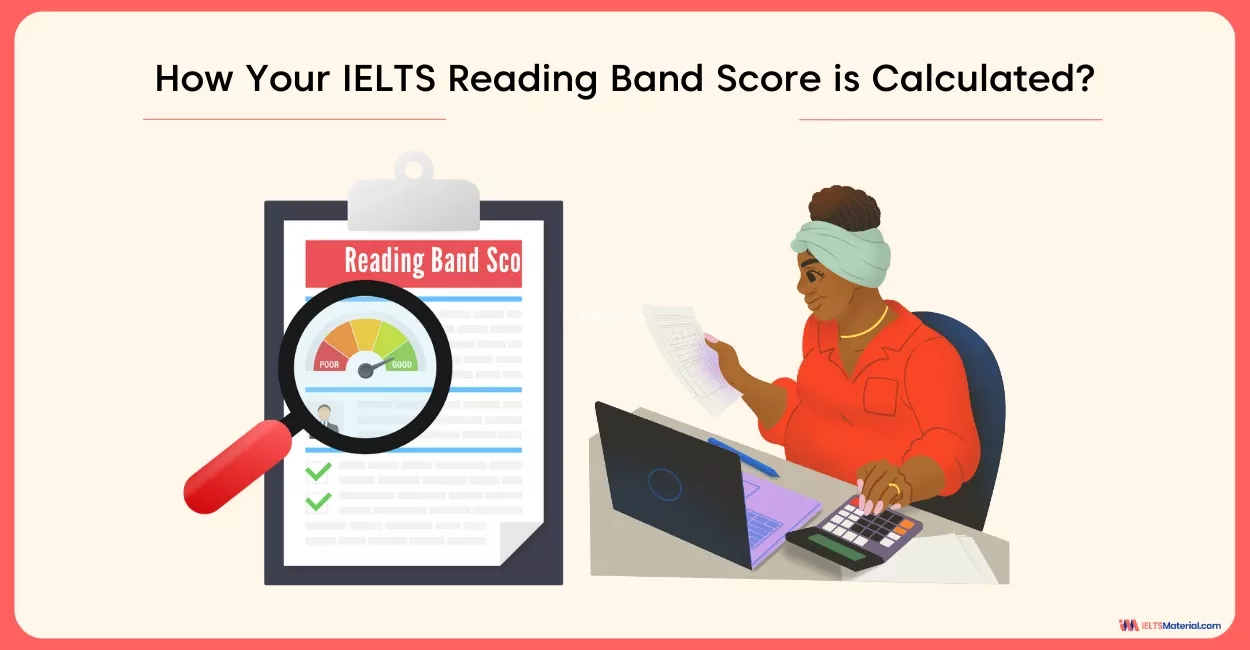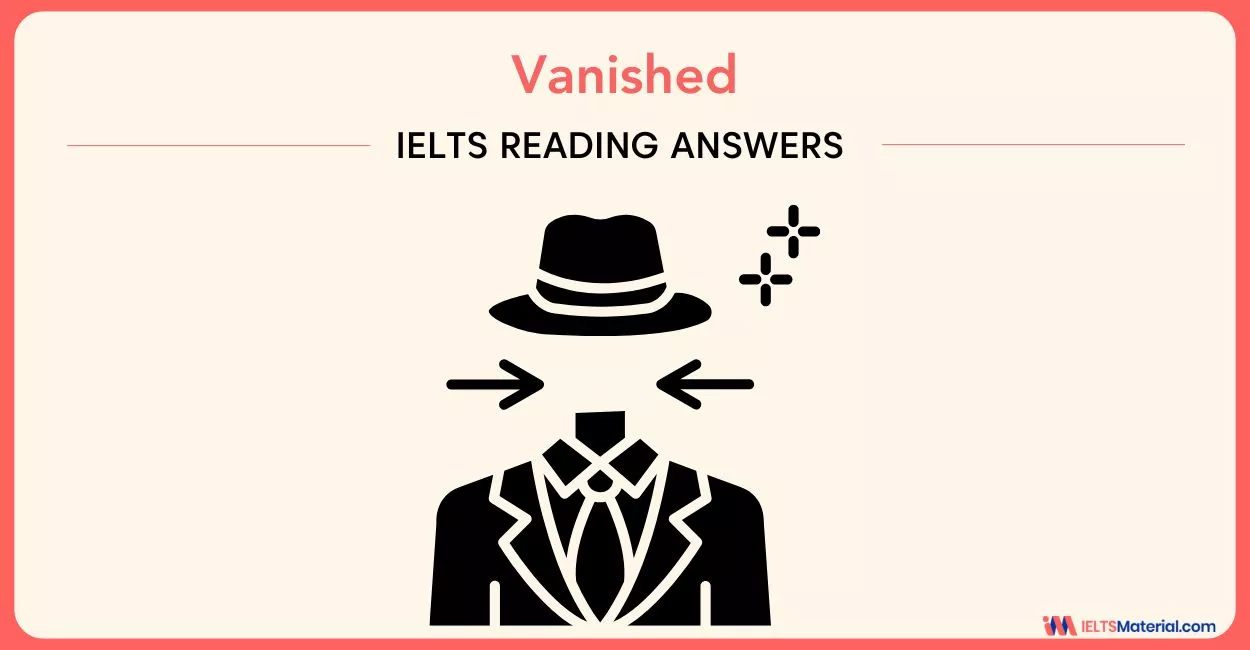Vanished - IELTS Reading Answers
10 min read
Updated On
-
Copy link
Prepare effectively with Vanished IELTS Reading Answers. This blog includes solutions with location and explanation to sharpen comprehension, with strategies to handle reading questions and maximize your chances of scoring band 7+ in the reading module.
Table of Contents

Limited-Time Offer : Access a FREE 10-Day IELTS Study Plan!
The key to consistent IELTS Reading progress is regular evaluation and score tracking through practice of practice tests. However, many candidates feel frustrated when they cannot complete the test in the limited time. Therefore, it is best to start with single reading passages, like ‘Vanished IELTS Reading Answers’, and learning how to complete IELTS Reading in less than an hour.
In this blog, solve the questions with the passage, ‘Vanished Reading Answers’, check your answers against the provided location and explanations to improve your performance in the reading module.
Passage for Vanished Reading Answers
You can use the 'Vanished' Reading Answers passage provided below as practice for the IELTS reading exam. Go through the passage given below, and be prepared to solve similar IELTS Reading topics for General and Academic for the reading section.
You should spend about 20 minutes on Questions 1-13, which are based on the reading passage below.
Vanished
A. Who pulled the plug on the Mediterranean? And could it happen again? By Douglas McInnis Cannes. Monte Carlo. St. Tropez. Magic names all. And much of the enchantment comes from the deep blue water that laps their shores. But what if somebody pulled the plug? Suppose the Mediterranean Sea was to vanish, leaving behind an expanse of the salt desert the size of India. Hard to imagine? It happened.
‘It would have looked like Death Valley,’ says Bill Ryan, from the Lamont-Doherty Earth Observatory in New York, one of the leaders of the team that discovered the Mediterranean had once dried up, then refilled in a deluge of Biblical proportions. Between five and six million years ago, the great desiccation touched off what scientists call the Messinian Salinity Crisis – a global chemical imbalance that triggered a wrenching series of extinctions and plunged the Earth into an ice age.
B. The first indications of some extraordinary past events came in the 1960s when geologists discovered that major rivers flowing into the Mediterranean had eroded deep canyons in the rock at the bottom of the sea. River erosion of bedrock cannot occur below sea level, yet somehow the River Rhone in the South of France had managed to create a channel 1000 meters deep in the seafloor, while the Nile had cut nearly 1500 meters into the rock off the North African coast. There was more: despite the fact that the formation of caves can only take place above water, scientists discovered a whole network beneath the island of Malta that reached an astonishing depth of 2000 meters below sea level.
C. Further evidence came to light in 1970 when an international team chugged across the Mediterranean in a drilling ship to study the seafloor near the Spanish island of Majorca. Strange things started turning up in core samples: layers of microscopic plants and soil sandwiched between beds of salt more than two kilometers below today’s sea level. The plants had grown in sunlight. Also discovered inside the rock were fossilized shallow-water shellfish, together with salt and silt: particles of sand and mud that had once been carried by river water. Could the seafloor once have been near a shoreline?
That question led Ryan and his fellow team leader, Kenneth Hsu, to piece together a staggering chain of events. About 5.8 million years ago, they concluded, the Mediterranean was gradually cut off from the Atlantic Ocean when continental drift pinned Morocco against Spain. As the opening became both narrower and shallower, the deep outward flow from sea to the ocean was progressively cut off, leaving only the shallow inward flow of ocean water into the Mediterranean. As this water evaporated, the sea became more saline and creatures that couldn’t handle the rising salt content perished. ‘The sea’s interior was dead as a doornail, except for bacteria,’ says Ryan. When the shallow opening at Gibraltar finally closed completely, the Mediterranean, with only rivers to feed it, dried up and died.
D. Meanwhile, the evaporated water was falling back to Earth as rain. When the fresh water reached the oceans, it made them less saline. With less salt in it to act as an antifreeze, parts of the ocean that would not normally freeze began to turn to ice. ‘The ice reflects sunlight into space,’ says Ryan. ‘The planet cools. Do you drive yourself into an ice age?
Eventually; a small breach in the Gibraltar dam sent the process into reverse. Ocean water cut a tiny channel to the Mediterranean. As the gap enlarged, the water flowed faster and faster; until the torrent ripped through the emerging Straits of Gibraltar at more than 100 knots. *The Gibraltar Falls was 100 times bigger than Victoria Falls and a thousand times grander than Niagara,’ Hsu wrote in his book The Mediterranean was a Desert (Princeton University Press, 1983).
E. In the end, the rising waters of the vast inland sea drowned the falls and warm water began to escape to the Atlantic, reheating the oceans and the planet. The salinity crisis ended about 5.4 million years ago. It had lasted roughly 400,000 years. Subsequent drilling expeditions have added a few wrinkles to Ryan and Hsu’s scenario. For example, researchers have found salt deposits more than two kilometers thick — so thick, some believe, that the Mediterranean must have dried up and refilled many times. But those are just geological details. For tourists, the crucial question is, could it happen again? Should Malaga start stockpiling dynamite?
Not yet, says Ryan. If continental drift does reseal the Mediterranean, it won’t be for several million years. ‘Some future creatures may face the issue of how to respond to nature‘s closure. It’s not something our species has to worry about.’
Questions for Vanished Reading Answers
The passage, Vanished Reading Answers, consists of 13 questions, which showcase three different IELTS Reading question types. They are:
- IELTS Reading Summary Completion (Q. 1-5)
- IELTS Reading Matching Endings (Q. 6-8)
- IELTS Reading Multiple Choice Questions (Q. 9-13)
Questions 1-5
Complete the summary below.
Choose NO MORE THAN THREE WORDS from the passage for each answer.
The 1960s discovery of 1…………………….. in the bedrock of the Mediterranean, as well as deep caves beneath Malta, suggested something strange had happened in the region, as these features must have been formed 2……………. sea level. Subsequent examination of the 3……………. off Majorca provided more proof. Rock samples from 2000 meters down contained both vegetation and 4…………………….. that could not have lived in deep water, as well as 5…………………….. originally transported by river.
Questions 6-8
Complete each of the following statements with the best ending.
A Africa and Europe crashed into each other.
B water started flowing from the Mediterranean.
C The sea was cut off from the ocean.
D all the fish and plant life in the Mediterranean died.
E the Earth started to become colder.
F The channel grew bigger, creating the waterfalls.
G all the ice on earth melted.
6 The extra ice did not absorb the heat from the sun, so ………..
7 The speed of the water from the Atlantic increased as ………..
8 The Earth and its oceans become warmer when …………….
Question 9-13
Choose the appropriate letters A, B, C or D.
9 What, according to Ryan and Hsu, happened about 5.8 million years ago?
A Movement of the continents suddenly closed the Straits of Gibraltar.
B The water level of the Atlantic Ocean gradually fell.
C The flow of water into the Mediterranean was immediately cut off.
D Water stopped flowing from the Mediterranean to the Atlantic.
10 Why did most of the animal and plant life in the Mediterranean diet?
A The water became too salty.
B There was such a lot of bacteria in the water
C The rivers did not provide salt water.
D The sea became a desert.
11 According to the text, the events at Gibraltar led to
A a permanent cooling of the Earth.
B the beginning and the end of an ice age.
C The formation of waterfalls elsewhere in the world.
D a lack of salt in the oceans that continues to this day.
12 More recent studies show that
A Ryan and Hsu’s theory was correct in every detail.
B the Mediterranean was never cut off from the Atlantic.
C it may have been cut off more than once.
D it might once have been a freshwater lake.
13 At the end of the article, Ryan suggests that
A the Mediterranean will never dry up again.
B humans will have the technology to prevent it drying up again.
C the Mediterranean is certain to dry up again one day.
D humans will never see the Mediterranean dry up.
Learn quick methods to conquer passages like ‘Vanished’ within 20 minutes.
Join our FREE IELTS webinars!
Answers for Vanished with Location and Explanations
It's time to double-check your responses to the Vanished IELTS Reading passage using the answer key provided below. Don’t forget to create strategies based on the feedback from this practice and master IELTS Reading question types with examples.
Unlock Answers
| Question number | Answer | Keywords | Location of keywords |
|---|---|---|---|
| 1 | Deep canyons | The first indications of some extraordinary past events came in the 1960s when geologists discovered that major rivers flowing into the Mediterranean had eroded deep canyons in the rock at the bottom of the sea. | Paragraph B;
Line 1 |
| 2 | Above | There was more: despite the fact that the formation of caves can only take place above water, | Paragraph B;
Last line |
| 3 | seafloor | Further evidence came to light in 1970, when an international team chugged across the Mediterranean in a drilling ship to study the sea floor near the Spanish island of Majorca. | Paragraph C;
Line 1 |
| 4 | shellfish | Also discovered inside the rock were fossilized shallow-water shellfish, together with salt and silt: | Paragraph C;
Line 4 |
| 5 | silt/ sand and mud | salt and silt: particles of sand and mud that had once been carried by river water | Paragraph C;
Line 4 |
| 6 | E | The planet cools | Paragraph D;
Line 5 |
| 7 | F | Ocean water cut a tiny channel to the Mediterranean. As the gap enlarged, the water flowed faster and faster; until the torrent ripped through the emerging Straits of Gibraltar at more than 100 knots. | Paragraph D;
Lines 8 – 9 |
| 8 | B | In the end, the rising waters of the vast inland sea drowned the falls and warm water began to escape to the Atlantic, reheating the oceans and the planet. | Paragraph E;
Line 1 |
| 9 | D | About 5.8 million years ago, they concluded, the Mediterranean was gradually cut off from the Atlantic Ocean when continental drift pinned Morocco against Spain. | Paragraph C;
Line 7 |
| 10 | A | As this water evaporated, the sea became more saline and creatures that couldn’t handle the rising salt content perished. | Paragraph C;
Line 9 |
| 11 | B | With less salt in it to act as an antifreeze, parts of the ocean that would not normally freeze began to turn to ice.
& Eventually; a small breach in the Gibraltar dam sent the process into reverse. |
Paragraph D;
Line 3 & Paragraph D; Line 7 |
| 12 | C | some believe, that the Mediterranean must have dried up and refilled many times. | Paragraph E;
Line 4 |
| 13 | D | Not yet, says Ryan. If continental drift does reseal the Mediterranean, it won’t be for several million years. | Paragraph E;
Line 9 |
Master Academic Reading with our IELTS Reading guide for high scores on passages!
Tips to Solve the Passage Question Types in the Vanished Reading Answers
Let us check out some quick IELTS exam preparation tips for band score of 8+ to answer the passage question types in the Reading Answers of Vanished.
Summary Completion
- Scan for keywords: Look for key terms in the summary (e.g., ‘1960s discovery’, ‘deep caves’, ‘Majorca’) and match them with the text.
- Understand word limits: The instructions say “NO MORE THAN THREE WORDS”. Stick strictly to that.
- Check grammar fit: The inserted words must make grammatical sense in the sentence.
- Locate chronology: Summaries usually follow the passage order, so answers appear in sequence.
- Identify synonyms: The summary may paraphrase the passage (e.g., ‘vegetation’ → ‘microscopic plants’, ‘transported by river’ → ‘silt/sand particles’).
Example: For ‘discovery of 1…………… in the bedrock’, look for features mentioned in the 1960s discovery section (deep canyons).
Matching Endings
- Read the sentence stem carefully: Make sure you understand the incomplete sentence before looking at options.
- Spot cause & effect: Many endings describe a result (e.g., ‘so…’, ‘as…’). Look for logical connections.
- Match meaning, not just words: Don’t pick an ending just because it shares similar words. The meaning must logically complete the sentence.
- Eliminate wrong options: Cross out endings that clearly don’t make sense. Usually, there are extra endings.
- Follow passage order: These answers often follow the text’s flow.
Example: For ‘The extra ice did not absorb the heat from the sun, so…,’ look for what the text says about ice reflecting sunlight (‘the Earth started to become colder’).
Multiple Choice Questions
- Underline key parts of the question: Focus on time references (‘5.8 million years ago’), causes (‘Why did most life die?’), and results.
- Read all options carefully: Often 2–3 answers seem correct, but only one matches exactly.
- Use process of elimination: Remove answers that contradict the passage or overgeneralize.
- Look for paraphrasing: The passage rarely repeats the exact words in the options. For instance, ‘water became too salty’ = ‘rising salt content’.
- Beware of traps: Some answers are partly true but don’t answer the full question. Always match the precise detail.
Example: Q. 10 asks why life died → The passage says creatures couldn’t survive rising salinity, so the answer is A. The water became too salty.
Finally, reading samples from IELTS recent actual tests, such as Vanished IELTS Reading Answers, is crucial. Through them, you will boost your reading speed, recognize your weak areas, and become familiar with different types of reading questions. Therefore, keep taking these tests, and you will achieve the results you want.
Check More IELTS Reading Answers
Practice IELTS Reading based on question types

Start Preparing for IELTS: Get Your 10-Day Study Plan Today!
Explore other Reading Practice Tests

Kasturika Samanta

Kasturika Samanta

Kasturika Samanta

Nehasri Ravishenbagam
Recent Articles

Nehasri Ravishenbagam

Haniya Yashfeen

Haniya Yashfeen

Haniya Yashfeen




Post your Comments